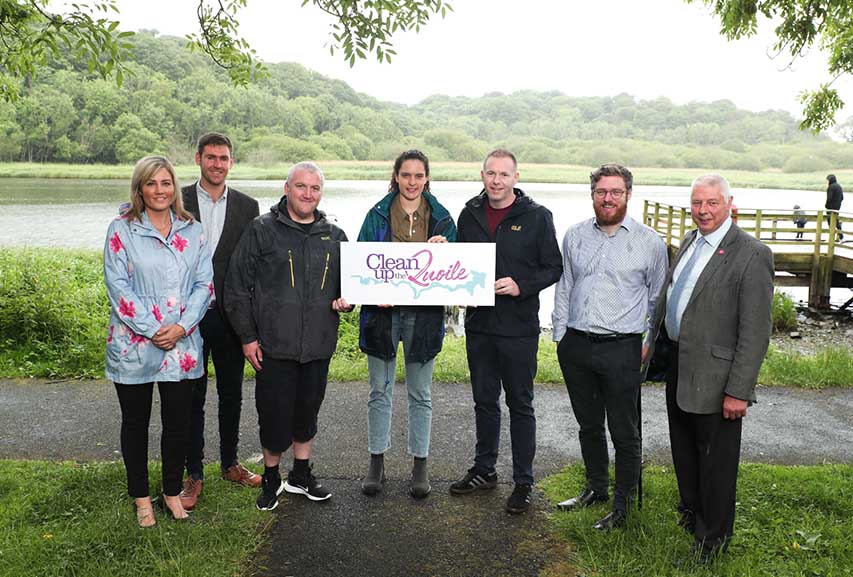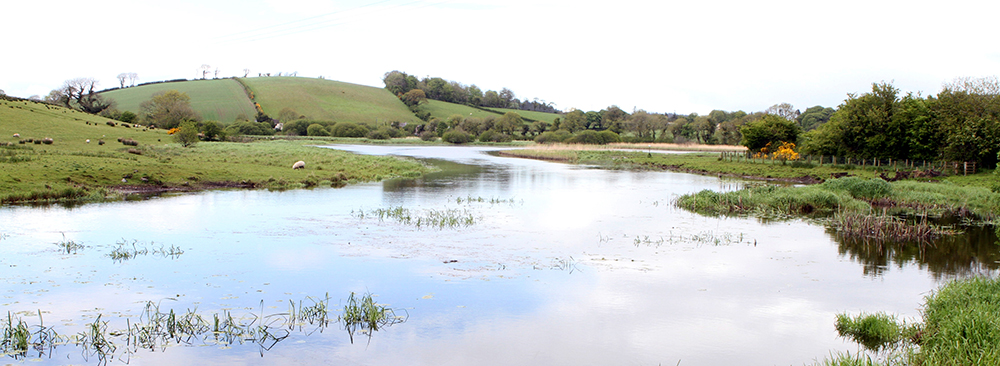Clean up the Quoile River addresses contamination issues and sees campaign launched
- Contamination along the River Quoile in Downpatrick threatens the health of users while it remains unclean. That’s the findings of water tests carried out by Clean up the Quoile in 2022
- High levels of E.coli, enterococci and coliforms found at Quoile River indicating presence of faecal contamination
- High levels of electrical conductivity and high levels of phosphates signalling poor water quality
A UK food producer and one of the largest employers in the Downpatrick area is spearheading a campaign to clean up the River Quoile.

Finnebrogue Artisan, located near the river in Downpatrick, has set up a steering group with local residents, anglers and sustainability experts. It has also received pledges of support from numerous agencies, including Newry Mourne Down Council, NIEA, Rivers Agency, Ulster Farmers Union and Strangford & Lecale Partnership; and all local political party representatives, including Sinn Fein, DUP, SDLP, Alliance and UUP.
The campaign group wants to see the river restored to its rightful status as Downpatrick’s finest natural asset, and are calling for a co-ordinated, multi-agency approach to address serious concerns about contamination.
Greta Delfino, sustainability manager at Finnebrogue Artisan and a member of the Clean up the Quoile campaign, claims a legacy of neglect has impacted the vulnerable eco-systems at the Quoile:
“Over the past 10 years, we have seen pollution from silt and sediment build up, algal blooms and invasive species playing havoc with the bio-diversity of this scenic area.
“A major fish kill at the river less than a year ago was a devastating blow to the many birds and wildlife that depend on the fish stocks for their own sustainability. It was also a concerning time for anglers.
“To avoid another major incident like this occurring again, we feel a co-ordinated, multi-agency approach is required. We want to see an end to ‘passing the buck’ and instead work together to create a masterplan that will improve water quality, restore bio-diversity, and improve sustainable recreational access to the river.
“To give some background on why this is needed, we conducted a series of water tests along the river in 2020 – in March, May and November – to scientifically understand the quality of water at the Quoile.
“E.coli and Enterococci were present in March and November – a possible result of faecal contamination – which is harmful to humans if ingested. Electrical conductivity was significantly elevated at Quoile Barrier and at the sewage works in March and November of that year which further indicates pollution present in the water.

“High levels of dissolved impurities in the water can be due to sewage works leaching chemicals from household products, and/or winter run off containing salt.
“Biological oxygen demand was very high in November which indicates organic pollution from plant decay and floods, as well as run off. This can endanger aquatic life through asphyxiation and disrupt the ecological balance of water.
“Although phosphorous is an essential nutrient for plants and animals, excessive levels were found in May of that year. This again indicates poor water quality which can cause explosive growth of algae, which in turn can cause harm to fish.”
The River Quoile is a landmark in County Down, spanning 27 miles from its mouth in Ballynahinch, flowing through Downpatrick to its output at Strangford Lough.
While the Quoile Estuary was once an important transport route, these days it’s more synonymous with dog walking and coarse fishing. However, it could be so much more if it was cleaned up.
Campaign manager, Anthea McAuley, explained that Clean up the Quoile is a community-led initiative and local people have been very clear about what they want.
“We conducted a survey in May 2022 asking local people what the Quoile area meant to them. Seventy-eight per cent of respondents said they believed the river was not in a good environmental condition, and this was preventing the Quoile area from reaching its full potential.
“They cited many reasons why they thought this was case – sewage, animal defecation, soil erosion and invasive species – but with proper investment they felt the Quoile area could be restored.
“The Quoile river could be a destination for water sports, fishing and recreation, a tourist hot spot where the rich history of the area can be embraced, an educational hub for learning about the world around us and a cultural asset that local people can be proud off.
“Local people have shared their memories of the Quoile with us, from The Thursday Fishing Club and participating in a ‘fishathon’ for Children in Need to having their wedding photos taken by the river to participating in raft races. We want a new generation of memories like these so it’s important the Quoile is cleaned up to facilitate that.”
Around 20 years ago, the failure of planning and regulatory authorities to comply with EU environmental directives earned Northern Ireland the unenviable label of the “dirty corner of the UK” from the UK Environmental Law Association (UKELA).
Stephen O’Hare, secretary of Quoile Anglers Association and a Clean up the Quoile member, claims not much has changed and now is the time for action.
“Local anglers spend a lot of time on the water and have witnessed first-hand how the water quality at the Quoile has deteriorated. This is backed up by a DAERA publication, ‘Water Framework Directive Statistics Report,’ which outlines how the quality of Northern Ireland waters in general have been downgraded.
“The report states that in 2015, 147 of the 450 river water bodies were classified as ‘good’ or ‘high overall’. In 2018, this dropped to 141, and in 2021, ZERO achieved ‘good’ or ‘high overall’ status. This is not acceptable in a green-age where the environment tops most agendas. Northern Ireland agencies need to work together to restore our river quality.”
We can all help to clean the River Quoile
Depleted oxygen levels in the lower regions of the River Quoile have been a concern for some time and this has been cited as a factor in recent fish kills by local agencies.
Clean up the Quoile want to conduct research at specific points along the river to assess water quality, particularly in the upland tributaries where it is felt some of the issues originate.
Blocked bridge tunnels and subsequent flooding can wash pollution into the river, so the group are keen to remedy problem areas with the support of relevant agencies.
The campaign group is not pointing a finger of blame at any one group for the current state of the Quoile and have taken steps to engage with all agencies. They state that anyone using the Quoile area has a responsibility to support the clean-up journey.
- The group is working with land stewards and farmers along the River Quoile as they journey together to help reduce river pollution and soil erosion. Fencing off, ensuring correct effluent and slurry management, planting trees and responsibly using fertiliser can all have a positive impact.
- The group is asking members of the public – including businesses and community groups – to become responsible custodians of the River Quoile area by always taking home their litter and cleaning up after their dogs. Empty bread bags, plastic wrappers and other litter can cause untold damage to the birds and wildlife.
- The wrong plant in the wrong place can be very damaging to the environment, and we’ve seen this in other UK and Irish waterways where Japanese/Giant Knotweed has invaded native species. There have been no sightings of knotweed along the Quoile to date, so it is important that any equipment that has been used in another waterway is cleaned and disinfected before leaving it. Seeds from invasive plants can easily transfer on boats, boards or fishing rods, and harm native plants, impacting on other species which rely on them, including fish, birds and other insects. Invasive plants can also form dense mats on water surfaces, preventing sunlight reaching native plants, and cause a drop in oxygen levels, leading to fish kill.
Clean up the Quoile is seeking volunteers to support with ongoing surveys and water testing, and would like to hear from under-graduate or post-graduate students who would consider the Quoile as a focus for their dissertation.
Clean up the Quoile have received a commitment of support from CAFRE to help with water testing and are already in discussions with QUB, Ulster University and RSPB on how they can support with research.
There is also an opportunity for local schools to get involved and learn more about local history and the bio-diverse world on our doorstep.
The group have set up a petition where local people can register their support for the campaign to clean up the River Quoile. You can follow the campaign on facebook @cleanthequoile and on twitter @cleanthequoile.
The Quoile is a river in County Down, Northern Ireland. It originates as the Ballynahinch River, flowing from west of Ballynahinch to Annacloy, where it is known as the Annacloy River. This then becomes the Quoile Proper, flowing through Downpatrick and the Quoile Pondage, before emptying into Strangford Lough.
The European Union’s Water Framework Directive (WFD) is the overarching water quality measure in Europe, requiring that water bodies be of good ecological status, covering indicators such as biological quality, chemical status and hydromorphological quality (Breen et al., 2018).
The Northern Ireland Environmental Agency (NIEA) is an Executive Agency within the Department of Agriculture, Environment and Rural Affairs (DAERA) in Northern Ireland. The primary purpose of the Agency is to protect and enhance Northern Ireland’s environment, delivering health and well-being benefits, as well as supporting economic growth. They are also the authority responsible for the WFD implementation, with Catchment Stakeholder Officers responsible for hosting bi-annual stakeholder groups within each of the catchments. The target status for rivers and waterbodies in 2021 was moderate, and good for 2027.
Queen’s University Publication on:
River pollution in Northern Ireland, Cave and McKibbin, 2016 indicates:
- 70% of public sewers in Northern Ireland are designed to collect both sewage and storm water. If there is intense rainfall, the capacity of the system is exceeded, which causes out-of-sewer flooding of untreated foul sewage.
- Excess application of phosphorous as fertilisers increases run-off into waterways (Adenuga et al., 2018). This increases eutrophication which has detrimental impacts on biodiversity, as well as water quality. Eutrophication has been identified as a significant pollution source in Northern Ireland. From 2001 to 2014, farm source was the highest pollution source, followed by industry, NI Water and ‘other’
























